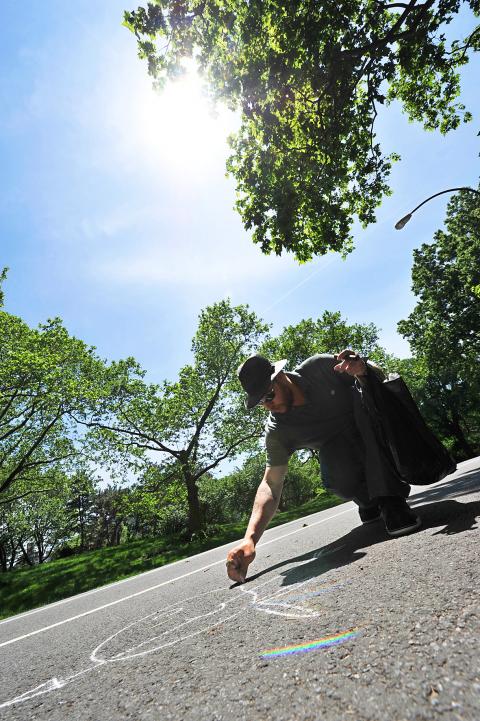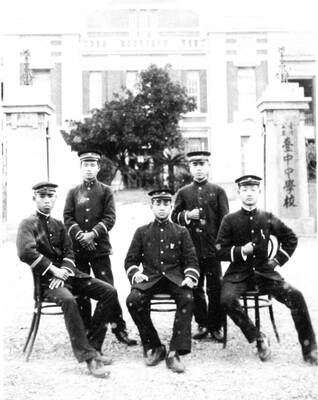James De La Vega has a message for New York — and he’s writing it all over the city.
A cigar-smoking street philosopher, De La Vega leaves mysterious sketches, sayings and exhortations in chalk on pavements, bike lanes, even garbage piles. He’s so prolific that while few know his face, the sidewalk seer has become one of the Big Apple’s most famous artists.
“Become your dream,” urges his signature motto, scrawled over the line drawing of a fish leaping from a bowl into a drinking glass and the signature “DELAVEGA.”

Photo: AFP
The curious words and designs, always in white chalk, appear outside subway stations or on sidewalks, often popping up overnight.
Instead of a bowl, there could be an hourglass, a love heart, a rain cloud, spear or other objects, with the fish sometimes replaced by a snake or turtle.
The accompanying words are brief, ambiguous. Like, “Sometimes the king is a woman.” Or, “Be mindful if your mind is full.”

Photo: AFP
Every day, teeming crowds of commuters walk over the temporary inscriptions, then rain eventually washes them away. De La Vega is relentless: he said in an interview that he can execute about 100 a day.
“I’m planting seeds,” he said.
New York has a rich history of street art, but De La Vega — who prefers to be addressed by his last name — insists he has nothing in common with the destructive impulses of graffiti.
He began in his home neighborhood of Spanish Harlem 20 years ago with murals on abandoned buildings that were meant to “beautify, to give people something to be proud of.”
Then along came the now iconic fish, “Become your dream,” and the rest of the growing repertoire. The fish, he says, “are not meant to beautify. These are strange things.”
De La Vega works at great speed, leaving his trace along streets in a pattern that seems to come instinctively, depending on where he is.
Recently he has taken to working his way through the asphalted paths and roads of Central Park, which in summer teems with tourists and armies of fitness-mad locals running the Loop.
De La Vega walked briskly against the torrent of runners, pausing briefly to sketch, throwing used stubs of chalk into the grass and reaching for fresh sticks.
Mostly the runners went right past, but some lost concentration for a second, glancing at the 37-year-old, whose body is emblazoned with tattoos reading “Become your dream,” “Legends never die” and the Spanish version of his catchphrase: “Realiza tu sueno.”
“This is a niche audience,” he said with compassion. “They’re very vulnerable. They probably have doubts about the future.”
A few hand movements later, he’d sketched a fish with long legs running across the path of the constant human flow.
“This stuff sinks in,” he said.
In the middle of the flow, a runner half-turned in surprise on recognizing the signature on the tarmac: “Hey, De La Vega!” A little later, a woman also did a double-take when she saw the fish.
“We like your art. My kids love it,” she grinned.
De La Vega makes little attempt to explain what he’s doing and refuses to speak about his background, an attitude only adding to his underground image.
Alongside the Central Park boating pond, he drew a fish in a bowl with a heart above and an empty bowl alongside. A group of children on a school outing stopped to watch.
“It’s some kind of duck,” one said.
“No, not a duck. It’s a bunny,” said another.
Walking on, the bemused children found the next installment — De La Vega often draws in series, almost like unspooling cartoon footage — and this time the fish was running from the bowl.
At the final scene, the children found fish leaping from both bowls and meeting in a kiss midway.
“Oh, it’s a fish jumping,” one of the children finally realized.
“We got a whole story,” another said.
“It’s a love story,” a third said.
Beaming, the children began
to clap.
Already, De La Vega was far ahead, drawing on the ground. He drew a fish running uphill toward a sack of US dollars. Next, he drew a fish in a bird cage watched by a free bird.
“Drawing for me is a way to explore,” the soft-spoken artist said. “My intention is remind people that they don’t have to be so powerless — that they can construct dreams.”
Then he took his chalk and walked on.

In the March 9 edition of the Taipei Times a piece by Ninon Godefroy ran with the headine “The quiet, gentle rhythm of Taiwan.” It started with the line “Taiwan is a small, humble place. There is no Eiffel Tower, no pyramids — no singular attraction that draws the world’s attention.” I laughed out loud at that. This was out of no disrespect for the author or the piece, which made some interesting analogies and good points about how both Din Tai Fung’s and Taiwan Semiconductor Manufacturing Co’s (TSMC, 台積電) meticulous attention to detail and quality are not quite up to

April 28 to May 4 During the Japanese colonial era, a city’s “first” high school typically served Japanese students, while Taiwanese attended the “second” high school. Only in Taichung was this reversed. That’s because when Taichung First High School opened its doors on May 1, 1915 to serve Taiwanese students who were previously barred from secondary education, it was the only high school in town. Former principal Hideo Azukisawa threatened to quit when the government in 1922 attempted to transfer the “first” designation to a new local high school for Japanese students, leading to this unusual situation. Prior to the Taichung First

Chinese Nationalist Party (KMT) Chairman Eric Chu (朱立倫) hatched a bold plan to charge forward and seize the initiative when he held a protest in front of the Taipei City Prosecutors’ Office. Though risky, because illegal, its success would help tackle at least six problems facing both himself and the KMT. What he did not see coming was Taipei Mayor Chiang Wan-an (將萬安) tripping him up out of the gate. In spite of Chu being the most consequential and successful KMT chairman since the early 2010s — arguably saving the party from financial ruin and restoring its electoral viability —

The Ministry of Education last month proposed a nationwide ban on mobile devices in schools, aiming to curb concerns over student phone addiction. Under the revised regulation, which will take effect in August, teachers and schools will be required to collect mobile devices — including phones, laptops and wearables devices — for safekeeping during school hours, unless they are being used for educational purposes. For Chang Fong-ching (張鳳琴), the ban will have a positive impact. “It’s a good move,” says the professor in the department of